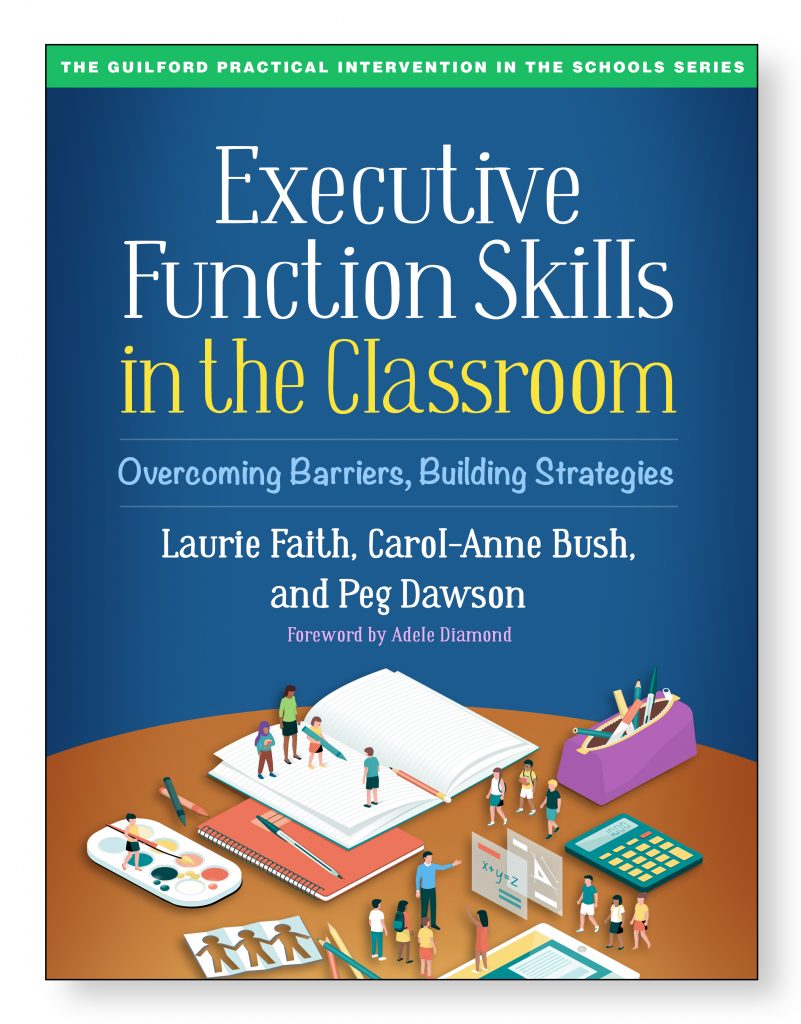Executive Function Skills in the Classroom: Overcoming Barriers, Building Strategies
Lovingly written during a two-year process of consultation and collaboration with over 30 Ontario teachers, our book is finally here! Discover a wide range of practical approaches to support executive functions and self-regulated learning. This book is published by Guilford Press and co-written by Carol-Anne Bush and Peg Dawson (Smart but Scattered). See below to read the preface by Adele Diamond.

Preface to Executive Function Skills in the Classroom
Adele Diamond, Canada Research Chair Tier 1 Professor of Developmental Cognitive Neuroscience
This book presents an approach to teaching in which understanding executive functions (EFs) is central. The book is written by educators for educators from Pre-K through high school. There is much wisdom here. Several aspects of the approach stand out.
Students with weak EFs are often subject to harsh misattributions by peers, teachers, and themselves because their failures to follow instructions or the rules can easily be mistaken as being intentional and indicative of poor character. This book provides a perspective and vocabulary for seeing learning and behavioral challenges in a whole new light, one that tries to identify what the problem is that is causing the learning or behavioral challenges and what the child can do to overcome that problem. For example, a student’s paper might still be blank long after the class was given a writing assignment. Does the student not know the material or could it be a problem with task initiation, organization, or with feeling what he or she writes must be perfect? Building basic EF-literacy among children allows them to finally speak clearly about their experiences, challenges, and learning. Once the problem is identified, the whole class can brainstorm about what might be done about that. Usually other students have had problems with that too and can share what has worked for them. During whole-class discussions, the silence is broken and students see that their friends and even their teacher also experience difficulties. Not only do students learn they are not alone, but as research shows, children and teens learn better from other young people than from adults. Often the challenges and strategies shared by peers seem more interesting, relevant, and useful than what adults’ offer.
This approach recognizes how much work teachers are expected to get through every day and that there is little time in the school day for adding anything else. Instead of proposing a new EF module, AL incorporates EF training seamlessly into whatever the class is doing, whether that is math or recess. Not only do teachers not have time for free-standing lessons on EFs, research shows that such an approach is not a good strategy for improving EFs. Gains from such lessons too rarely generalize to life outside those lessons or to academic subjects. Instead, this approach has students apply EF concepts during academic and social learning experiences. Research shows it is by using concepts that we truly learn them; otherwise we understand them only at an abstract, intellectual level.
The practices described in this book are neither formulaic nor scripted. The authors, Faith, Bush, and Dawson recognize that one size never fits everyone. Each teacher, each student, and each class is different. Multiple strategies and a plethora of examples are provided to help teachers see how they can use the approach in a way that feels thoroughly comfortable. Scripted lessons are easier, but research shows they are less effective – too easy for some, too difficult for others, too boring, too out of touch with the reality in particular classrooms – and teachers are too bright and capable to be treated like robots who are simply to do exactly as they are told.
Central to this book is a deep respect for both teachers and for students, an acknowledgement that people get more benefit from any activity and enjoy it more if they have some say in how the activity is implemented, and the recognition that no one of us is as smart as all of us collectively. Using this approach, students and teachers discuss EF obstacles they face and co-create strategies. Central to this approach is the Barriers & Strategies Protocol, which provides ways to strategize with students instead of for students. Students are actively involved in the process of identifying problems and in developing suitable responses.
Because of this shared problem-solving and brainstorming, no teacher needs to be an EF or strategy expert. Solutions arise through the communal discussion. Feeling they have to be the expert can be anxiety-provoking or overwhelming for some teachers. There’s no need to feel that way here. And, the authors provide a plethora of examples of possible solutions that teachers and citizens can adopt or modify as they wish.
As I read this book, I kept writing in the margin “I love it.” It contains so much wisdom and is written in a clear, engaging manner without any sense that the authors are watering things down too much. Real-life examples from the classroom greatly help to illustrate and elaborate points. I would recommend this book to all educators.


